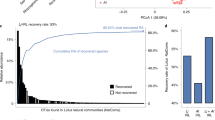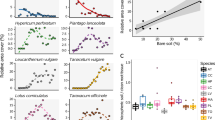Abstract
The plant root defines the interface between a multicellular eukaryote and soil, one of the richest microbial ecosystems on Earth1. Notably, soil bacteria are able to multiply inside roots as benign endophytes and modulate plant growth and development2, with implications ranging from enhanced crop productivity3 to phytoremediation4. Endophytic colonization represents an apparent paradox of plant innate immunity because plant cells can detect an array of microbe-associated molecular patterns (also known as MAMPs) to initiate immune responses to terminate microbial multiplication5. Several studies attempted to describe the structure of bacterial root endophytes6; however, different sampling protocols and low-resolution profiling methods make it difficult to infer general principles. Here we describe methodology to characterize and compare soil- and root-inhabiting bacterial communities, which reveals not only a function for metabolically active plant cells but also for inert cell-wall features in the selection of soil bacteria for host colonization. We show that the roots of Arabidopsis thaliana, grown in different natural soils under controlled environmental conditions, are preferentially colonized by Proteobacteria, Bacteroidetes and Actinobacteria, and each bacterial phylum is represented by a dominating class or family. Soil type defines the composition of root-inhabiting bacterial communities and host genotype determines their ribotype profiles to a limited extent. The identification of soil-type-specific members within the root-inhabiting assemblies supports our conclusion that these represent soil-derived root endophytes. Surprisingly, plant cell-wall features of other tested plant species seem to provide a sufficient cue for the assembly of approximately 40% of the Arabidopsis bacterial root-inhabiting microbiota, with a bias for Betaproteobacteria. Thus, this root sub-community may not be Arabidopsis-specific but saprophytic bacteria that would naturally be found on any plant root or plant debris in the tested soils. By contrast, colonization of Arabidopsis roots by members of the Actinobacteria depends on other cues from metabolically active host cells.
This is a preview of subscription content, access via your institution
Access options
Subscribe to this journal
Receive 51 print issues and online access
$199.00 per year
only $3.90 per issue
Buy this article
- Purchase on Springer Link
- Instant access to full article PDF
Prices may be subject to local taxes which are calculated during checkout




Similar content being viewed by others
Accession codes
References
Tringe, S. G. et al. Comparative metagenomics of microbial communities. Science 308, 554–557 (2005)
Hardoim, P. R., van Overbeek, L. S. & Elsas, J. D. Properties of bacterial endophytes and their proposed role in plant growth. Trends Microbiol. 16, 463–471 (2008)
Mei, C. & Flinn, B. S. The use of beneficial microbial endophytes for plant biomass and stress tolerance improvement. Recent Pat. Biotechnol. 4, 81–95 (2010)
Weyens, N., van der Lelie, D., Taghavi, S. & Vangronsveld, J. Phytoremediation: plant–endophyte partnerships take the challenge. Curr. Opin. Biotechnol. 20, 248–254 (2009)
Rosenblueth, M. & Martinez-Romero, E. Bacterial endophytes and their interactions with hosts. Mol. Plant Microbe Interact. 19, 827–837 (2006)
Reinhold-Hurek, B. & Hurek, T. Living inside plants: bacterial endophytes. Curr. Opin. Plant Biol. 14, 435–443 (2011)
Pruesse, E. et al. SILVA: a comprehensive online resource for quality checked and aligned ribosomal RNA sequence data compatible with ARB. Nucleic Acids Res. 35, 7188–7196 (2007)
Gans, J., Wolinsky, M. & Dunbar, J. Computational improvements reveal great bacterial diversity and high metal toxicity in soil. Science 309, 1387–1390 (2005)
Berg, G. & Smalla, K. Plant species and soil type cooperatively shape the structure and function of microbial communities in the rhizosphere. FEMS Microbiol. Ecol. 68, 1–13 (2009)
İnceoğlu, Ö., Al-Soud, W. A., Salles, J. F., Semenov, A. V. & van Elsas, J. D. Comparative analysis of bacterial communities in a potato field as determined by pyrosequencing. PLoS ONE 6, e23321 (2011)
Hardoim, P. R. et al. Rice root-associated bacteria: insights into community structures across 10 cultivars. FEMS Microbiol. Ecol. 77, 154–164 (2011)
Lundberg, D. S. et al. Defining the core Arabidopsis thaliana root microbiome. Naturehttp://dx.doi.org/10.1038/nature11237 (this issue)
Fierer, N., Bradford, M. A. & Jackson, R. B. Toward an ecological classification of soil bacteria. Ecology 88, 1354–1364 (2007)
Basilio, A. et al. Patterns of antimicrobial activities from soil actinomycetes isolated under different conditions of pH and salinity. J. Appl. Microbiol. 95, 814–823 (2003)
Benson, A. K. et al. Individuality in gut microbiota composition is a complex polygenic trait shaped by multiple environmental and host genetic factors. Proc. Natl Acad. Sci. USA 107, 18933–18938 (2010)
Boller, T. & Felix, G. A renaissance of elicitors: perception of microbe-associated molecular patterns and danger signals by pattern-recognition receptors. Annu. Rev. Plant Biol. 60, 379–406 (2009)
Chelius, M. K. & Triplett, E. W. The diversity of archaea and bacteria in association with the roots of Zea mays L. Microb. Ecol. 41, 252–263 (2001)
Buchholz-Cleven, B. E. E., Rattunde, B. & Straub, K. L. Screening for genetic diversity of isolates of anaerobic Fe(II)-oxidizing bacteria using DGGE and whole-cell hybridization. Syst. Appl. Microbiol. 20, 301–309 (1997)
Kunin, V. & Hugenholtz, P. PyroTagger: a fast, accurate pipeline for analysis of rRNA amplicon pyrosequence data. Open J. Article–1 (2010)
Eickhorst, T. & Tippkotter, R. Improved detection of soil microorganisms using fluorescence in situ hybridization (FISH) and catalyzed reporter deposition (CARD-FISH). Soil Biol. Biochem. 40, 1883–1891 (2008)
Pernthaler, A., Pernthaler, J. & Amann, R. Fluorescence in situ hybridization and catalyzed reporter deposition for the identification of marine bacteria. Appl. Environ. Microbiol. 68, 3094–3101 (2002)
Timmusk, S., Grantcharova, N. & Wagner, E. G. H. Paenibacillus polymyxa invades plant roots and forms biofilms. Appl. Environ. Microbiol. 71, 7292–7300 (2005)
Acknowledgements
We thank R. Franzen and S. Schumacher for technical assistance, S. Wulfert for providing Arabidopsis liquid cultures, H. Schmidt for sharing the CARD-FISH protocol and performing the cell counts. We thank S. Klages and K. Stüber for support with bioinformatic pipelines. We are grateful to R. Panstruga and P. Bakker for comments on the manuscript. Golm soil was shipped by J. Schwachtje and J. van Dongen. This work was supported by funds from the Max Planck Society to P.S.-L. (M.IF. A. ZUCH8048). K.S. is supported by the Swiss National Science Foundation (PBFRP3-133544).
Author information
Authors and Affiliations
Contributions
D.B., M.R., K.S., F.A., and E.V.L.v.T performed the experiments and analysed the data. M.R. and T.E. performed CARD-FISH experiments. E.S. generated SEM micrographs. E.V.L.v.T. coordinated computational analyses. N.A. performed the RDP classification. J.P. performed the SILVA classification. F.O.G. provided access to SILVA classification and R.A. advice on CARD-FISH, SILVA analysis. B.H. and R.R. performed pyrosequencing of amplicon libraries. D.B., M.R., K.S., P.R. and P.S.-L. designed the study. D.B., M.R., K.S., E.V.L.v.T and P.S.-L. wrote the manuscript. D.B., M.R., K.S. and E. V.L.v.T. contributed equally to this work. All authors discussed the results and commented on the manuscript.
Corresponding author
Ethics declarations
Competing interests
The authors declare no competing financial interests.
Additional information
Pyrosequencing reads have been deposited in the NCBI Sequence Read Archive (SRA) database (SRA043581). The R scripts used for computational analyses are available via http://www.mpipz.mpg.de/162701/R_scripts.
Supplementary information
Supplementary Information
This file contains Supplementary Methods, Supplementary References, Supplementary Figures 1-19 and Supplementary Tables 1-6. (PDF 3411 kb)
Supplementary Movie 1
This zipped movie file illustrates how the roots of the soil grown plants were sampled. (ZIP 16790 kb)
Supplementary Data 1
This zipped file contains an excel file and a separate worksheet comprising the dataset description, sequencing information, the PyroTagger output file, raw and rarefied OTU count matrices, statistical analyses and identified taxa with counts at multiple taxonomic ranks assigned using SILVA and RDP databases. Worksheets indicated with the letter A contain calculation performed with the removal of reads and OTUs assigned to the phylum Chloroflexi. Worksheets indicated with the letter B contain calculation performed including reads and OTUs assigned to the phylum Chloroflexi. (ZIP 8125 kb)
Supplementary Data 2
This zipped file contains an excel file and three separate worksheets that contain the dataset description, the PyroTagger output file, the taxonomy classification of OTUs according to SILVA database of the samples utilized for the PCR primers comparison. (ZIP 7144 kb)
Rights and permissions
About this article
Cite this article
Bulgarelli, D., Rott, M., Schlaeppi, K. et al. Revealing structure and assembly cues for Arabidopsis root-inhabiting bacterial microbiota. Nature 488, 91–95 (2012). https://doi.org/10.1038/nature11336
Received:
Accepted:
Published:
Issue Date:
DOI: https://doi.org/10.1038/nature11336
This article is cited by
-
Selective regulation of endophytic bacteria and gene expression in soybean by water-soluble humic materials
Environmental Microbiome (2024)
-
Dynamic root microbiome sustains soybean productivity under unbalanced fertilization
Nature Communications (2024)
-
Nonpathogenic Pseudomonas syringae derivatives and its metabolites trigger the plant “cry for help” response to assemble disease suppressing and growth promoting rhizomicrobiome
Nature Communications (2024)
-
Chromosomal barcodes for simultaneous tracking of near-isogenic bacterial strains in plant microbiota
Nature Microbiology (2024)
-
Different responses of soil fauna gut and plant rhizosphere microbiomes to manure applications
Soil Ecology Letters (2024)
Comments
By submitting a comment you agree to abide by our Terms and Community Guidelines. If you find something abusive or that does not comply with our terms or guidelines please flag it as inappropriate.



